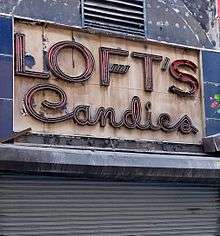Loft, Inc.

Loft, Inc. was the largest maker and seller of candy in the world in 1920's. It manufactured its own products and distributed them throughout greater New York City and Newark, New Jersey.[1] Happiness Candy Stores, Inc., was controlled by Loft, Inc.[2] Loft, Inc., merged with PepsiCo following an agreement of merger filed in Wilmington, Delaware in June 1941.[3]
Business history
In 1860, English immigrant William Loft opened a candy store in Lower Manhattan. Loft's two sons followed in his footsteps, with his eldest son George W. Loft taking charge of the company in the 1890s. George Loft soon opened two more stores, then added more in New York City as he moved production out of the family kitchen into a series of increasingly large factories, the latter of which culminated in a location in Long Island City.[4]
On March 31, 1921, Loft, Inc., declared its initial dividend of .25 per share.[5]
In 1934 and 1935, the company conducted an advertising and sales campaign against its competitors which was judged to be disparaging by the Federal Trade Commission. The regulatory agency ordered it to cease and desist from representing glucose used in candy, as being impure, harmful to the health, or unwholesome, or unsafe.[6]
In 1939, a notable case Guth v. Loft Inc. was decided in favor of Loft and against Charles Guth, president and general manager.
Ten factory and office buildings at the northeast corner of Fortieth Avenue and Vernon Boulevard, extending to Ninth Street in Long Island City, were owned by Loft, Inc. They were sold to the Loft Realty Corporation in April 1941. The structures stood on an irregular plot which measured 400 by 450 feet.[7] They also had a store on 55th Street and 5th Avenue in Sunset Park, Brooklyn.
Loft's candy operations were spun off from the new Pepsi-Cola Corporation in 1941, an immediate result of the Loft-Pepsi merger. The newly independent Loft Candy Corporation attracted the attention of Philadelphia magnate Albert M. Greenfield, whose City Stores Company (CSCo) rapidly acquired control of the new company. Under CSCo management appointed by Greenfield, Loft Candy expanded into New York state, New Jersey, and New England. The company also opened stores in some of the larger stations of the New York City subway system. By 1958, approaching the centennial of Loft's, the company owned or controlled stores in the Eastern Seaboard and the Midwest, in 11 states and the District of Columbia, with over $17 million in sales and 2,100 employees. Loft's 350 different candy products were also sold in CSCo and independent department (and smaller variety and drug) stores in an area covering 15 states and the nation's capitol.[4]
References
- ↑ Loft, Inc., Wall Street Journal, November 1, 1916, pg. 2.
- ↑ Happiness Candy Stores, Wall Street Journal, February 23, 1939, pg. 7.
- ↑ Loft, Pepsi-Cola Merger Filed, Wall Street Journal, July 1, 1941, pg. 2.
- 1 2 Woods, Clinton. "Brand Name Cooking with Loft Candy [excerpt]". Ideas That Became Big Business. Founders, Inc: Baltimore, Maryland. Retrieved 3 January 2013.
- ↑ Loft Declares First Dividend, New York Times, January 15, 1921, pg. 20.
- ↑ Loft Cited by FTC, Wall Street Journal, February 8, 1937, pg. 5.
- ↑ Queens Plants Conveyed, New York Times, April 30, 1941, pg. 36.